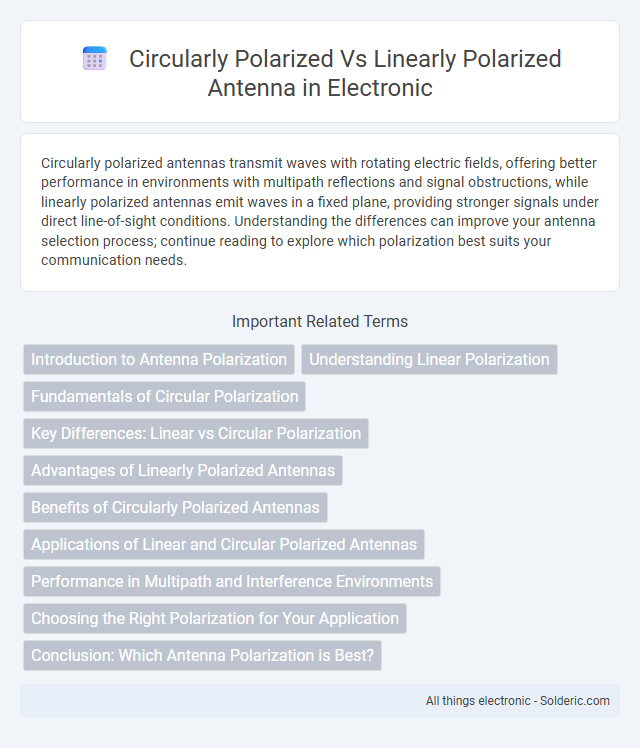Circularly polarized antennas transmit waves with rotating electric fields, offering better performance in environments with multipath reflections and signal obstructions, while linearly polarized antennas emit waves in a fixed plane, providing stronger signals under direct line-of-sight conditions. Understanding the differences can improve your antenna selection process; continue reading to explore which polarization best suits your communication needs.
Comparison Table
| Feature | Circularly Polarized Antenna | Linearly Polarized Antenna |
|---|---|---|
| Polarization Type | Circular (Right-hand or Left-hand) | Linear (Horizontal or Vertical) |
| Signal Orientation | Rotates 360deg over one wave period | Fixed plane direction |
| Interference Resistance | Better against multipath and polarization mismatch | More susceptible to polarization mismatch and fading |
| Typical Use Cases | Satellite communication, GPS, RFID | Wi-Fi, terrestrial broadcast, radar |
| Complexity | More complex design and manufacturing | Simpler design and cost-effective |
| Bandwidth | Moderate to wide bandwidth | Wide bandwidth |
| Antenna Gain | Slightly lower due to polarization loss | Higher gain in aligned orientations |
| Polarization Loss | Reduced; improves signal reliability | Higher if polarization does not match |
Introduction to Antenna Polarization
Antenna polarization describes the orientation of the electric field vector of an electromagnetic wave transmitted or received by an antenna, significantly affecting signal quality and compatibility. Circularly polarized antennas rotate the electric field in a helical pattern, enhancing performance in environments with multipath interference and variable signal orientations, while linearly polarized antennas maintain a fixed electric field direction, which can offer higher gain and simpler design. Understanding your communication system's polarization requirements ensures optimal antenna selection, reducing signal loss and improving overall transmission efficiency.
Understanding Linear Polarization
Linear polarization occurs when the electric field of a radio wave oscillates in a single plane, either horizontal or vertical, allowing for predictable signal orientation and reduced interference in aligned communication systems. This polarization type is commonly used in applications where the antenna orientation remains fixed, ensuring optimal signal strength and clarity. Understanding linear polarization helps you select the right antenna type to match your system's alignment and enhance overall transmission efficiency.
Fundamentals of Circular Polarization
Circular polarization occurs when the electric field of an antenna wave rotates in a circular motion, creating a helical wavefront that can improve signal reception from varying directions. Unlike linearly polarized antennas, which transmit waves oscillating in a single plane, circularly polarized antennas reduce multipath interference and signal degradation caused by reflections. Your communication system benefits from circular polarization by enhancing signal reliability in dynamic environments where antenna alignment constantly changes.
Key Differences: Linear vs Circular Polarization
Linear polarization transmits electromagnetic waves with the electric field oscillating in a single plane, making it ideal for point-to-point communication where antenna alignment is precise. Circular polarization rotates the electric field in a helical pattern, improving signal reception in environments with multipath interference or varying antenna orientations. Your choice between linear and circular polarization impacts system performance based on factors like signal reflection, polarization mismatch, and the nature of the communication link.
Advantages of Linearly Polarized Antennas
Linearly polarized antennas offer higher sensitivity and greater signal strength in environments with minimal multipath interference, enhancing overall communication quality. They provide simpler design and manufacturing processes, resulting in cost-effective solutions for many wireless applications. These antennas also facilitate easier alignment with corresponding receivers, improving signal reception efficiency in point-to-point communication systems.
Benefits of Circularly Polarized Antennas
Circularly polarized antennas offer enhanced signal reception by mitigating multipath interference and fading, making them ideal for satellite communications and mobile devices. Their ability to maintain consistent polarization regardless of orientation improves link reliability in dynamic environments. These antennas also reduce polarization mismatch losses, resulting in better overall system performance compared to linearly polarized antennas.
Applications of Linear and Circular Polarized Antennas
Linear polarized antennas are widely used in applications such as terrestrial television broadcasting, point-to-point microwave links, and radar systems where signal orientation consistency and high gain are critical. Circular polarized antennas are preferred in satellite communications, GPS systems, and mobile devices due to their ability to reduce multipath interference and maintain signal integrity regardless of antenna orientation. In RFID systems and aerospace communications, circular polarization enhances signal reliability by mitigating polarization mismatches and improving overall transmission quality.
Performance in Multipath and Interference Environments
Circularly polarized antennas significantly reduce multipath interference by receiving signals with varying phase shifts and orientations, enhancing signal consistency in urban and indoor environments. Linearly polarized antennas are more susceptible to signal degradation due to polarization mismatch caused by reflections and scattering, leading to decreased performance in complex propagation scenarios. In environments with high interference and multipath effects, circular polarization offers improved signal reliability and reduced fading.
Choosing the Right Polarization for Your Application
Selecting the appropriate antenna polarization depends heavily on the communication environment and device orientation. Circularly polarized antennas excel in dynamic settings with varying orientations, such as satellite and drone communications, reducing signal degradation caused by misalignment. In contrast, linearly polarized antennas are optimal for fixed, point-to-point links where transmitter and receiver maintain consistent alignment, offering higher gain and reduced complexity.
Conclusion: Which Antenna Polarization is Best?
Choosing the best antenna polarization depends on your communication needs and environment. Circularly polarized antennas excel in minimizing signal degradation caused by multipath and orientation changes, making them ideal for satellite and mobile applications. Linearly polarized antennas provide higher gain and are preferred for fixed point-to-point links where signal alignment is consistent and polarization mismatch is minimal.
circularly polarized vs linearly polarized antenna Infographic

 solderic.com
solderic.com